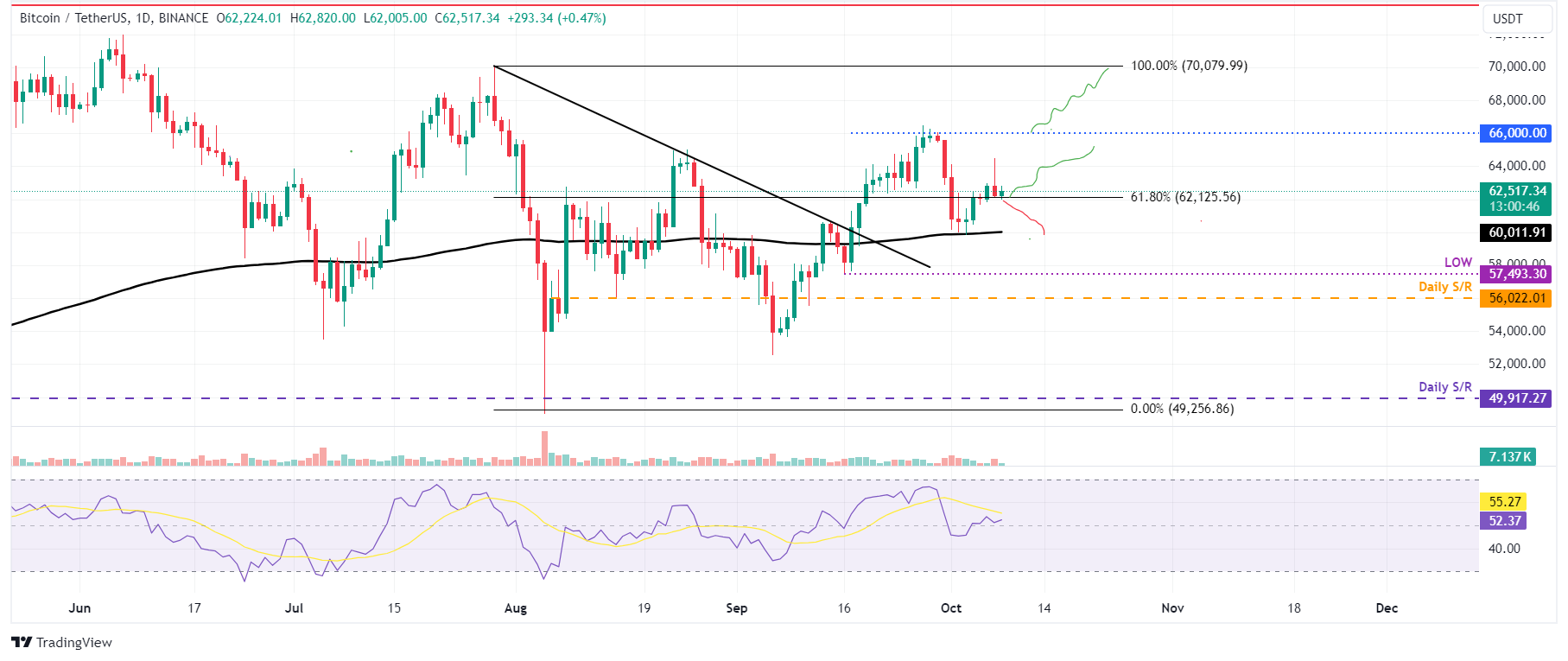- Bitcoin stabilizes just above the $62,000 level, eying for a rally ahead.
- US Spot ETF data recorded an inflow of $233.8 million on Monday.
- The Kobeissi Letter highlights how the rising Global M2 money supply could be a positive sign for Gold and Bitcoin.
Bitcoin (BTC) hovers slightly above $62,000 on Tuesday after a minor decline on Monday, buoyed by positive signs such as over $233 million in inflows into US Spot BTC Exchange Traded Funds (ETFs). At the same time, The Kobesissi Letter noted that the rising global M2 money supply could be a favorable signal for both Gold and Bitcoin.
Bitcoin may reach $90,000 by 2024 amid rising Global M2 money supply
According to a recent tweet from The Kobeissi Letter, the total money supply in the United States (US), the Euro area, Japan, and China has reached a new record of $89.7 trillion, with $7.3 trillion added over the last year. In the US alone, the amount of money in circulation has surged $410 billion year-over-year to $21.2 trillion. This marks the largest increase in three years and a similar jump to the initial pandemic response in the first half of 2020 when favoring economic policies and stimulus packages caused global money printing. Such a condition has generally seen Gold and Bitcoin prices rally in the long term.
Moreover, New York Digital Investment Group (NYDIG) reported last week that Bitcoin remains the best-performing asset this year, with a 49.2% year-to-date gain.
BREAKING: Total money supply in the US, the Euro Area, Japan, and China has reached a new record of a MASSIVE $89.7 trillion.
Global money supply has skyrocketed by $7.3 trillion over the last year.
This marks the largest increase in 3 years and a similar jump to the initial… pic.twitter.com/A5KrGCjCc0
— The Kobeissi Letter (@KobeissiLetter) October 1, 2024
Diving deep, Bitcoin has a history of rising alongside the M2 money supply, with a lag of 75 to 90 days. Most analysts expect a healthy rally for BTC as 2024 closes out despite any headwinds that may influence economic conditions.
According to market analyst Joe Consorti, the M2 trend suggests that Bitcoin could hit $90,000 by the end of 2024. Furthermore, CryptoQuant data also has a similar projection for Bitcoin price.
Additionally, US Bitcoin Spot Exchange Traded Funds (ETF) data recorded an inflow of $233.8 million on Monday. Studying the ETF flow data can be useful for observing institutional investors’ sentiment for Bitcoin. If this magnitude of inflow continues, demand for Bitcoin will increase, leading to a rise in its price.

Total Bitcoin Spot ETF Net Inflow chart. Source: Coinglass
Furthermore, Metaplanet Inc., a company publicly listed on the Tokyo Stock Exchange, announced on Monday an additional purchase of 108.786 bitcoin for a total investment of 1 billion yen (approximately $6.7 million). The average purchase price was 9.19 million yen per BTC. With this acquisition, Metaplanet’s total Bitcoin holdings now stand at 639.503 BTC. Metaplanet’s move could pave the way for broader adoption of Bitcoin and cryptocurrencies, among other companies.
Finally, crypto asset trading firm Capital QCP’s Monday report highlights the upcoming US Consumer Price Index (CPI) release on Thursday. “With the recent strong US wage and jobs numbers, the market will be paying close attention to this print for any signs of an uptick in inflation. Fed rate cut expectations have shifted from 50 bps to 25 bps in just a week, and this week’s data may determine if further cuts get priced out,” said QCP.
BTC holds $62,000 support level
Bitcoin price found support at the 200-day Exponential Moving Average (EMA), around $60,000, on October 2. It rose 3.5% in the following four days and broke above the $62,125 resistance level. As of Tuesday, BTC trades just above $62,000.
If the $62,125 holds as support, BTC could extend the rally to retest its psychological level of $66,000.
The Relative Strength Index (RSI) on the daily chart is at 52, just above its neutral level of 50, indicating a lack of momentum and indecisiveness among traders. For Bitcoin’s strength to be sustained, the RSI must rise above its neutral level and continue rising.

BTC/USDT daily chart
However, if the $62,125 level fails, BTC could decline to retest its 200-day EMA level at $60,000.
Bitcoin, altcoins, stablecoins FAQs
Bitcoin is the largest cryptocurrency by market capitalization, a virtual currency designed to serve as money. This form of payment cannot be controlled by any one person, group, or entity, which eliminates the need for third-party participation during financial transactions.
Altcoins are any cryptocurrency apart from Bitcoin, but some also regard Ethereum as a non-altcoin because it is from these two cryptocurrencies that forking happens. If this is true, then Litecoin is the first altcoin, forked from the Bitcoin protocol and, therefore, an “improved” version of it.
Stablecoins are cryptocurrencies designed to have a stable price, with their value backed by a reserve of the asset it represents. To achieve this, the value of any one stablecoin is pegged to a commodity or financial instrument, such as the US Dollar (USD), with its supply regulated by an algorithm or demand. The main goal of stablecoins is to provide an on/off-ramp for investors willing to trade and invest in cryptocurrencies. Stablecoins also allow investors to store value since cryptocurrencies, in general, are subject to volatility.
Bitcoin dominance is the ratio of Bitcoin’s market capitalization to the total market capitalization of all cryptocurrencies combined. It provides a clear picture of Bitcoin’s interest among investors. A high BTC dominance typically happens before and during a bull run, in which investors resort to investing in relatively stable and high market capitalization cryptocurrency like Bitcoin. A drop in BTC dominance usually means that investors are moving their capital and/or profits to altcoins in a quest for higher returns, which usually triggers an explosion of altcoin rallies.

























